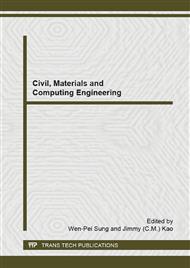p.103
p.110
p.118
p.127
p.131
p.135
p.140
p.144
p.148
Research on Optimizing Parameters for Suppressing Vibration of MSCSS under Earthquake Excitation
Abstract:
The dynamic characteristics and the control performances of Mega-Sub Controlled Structure Systems (MSCSS) is investigated in the paper. The control parameters of the structure system, such as the stiffness ratio (RD); the mass ratio of the mega-structure and sub-structure (RM) are studied and their optimal values are obtained in order to achieve better control performances when it is subjected to strong earthquake excitations. Then, trough the nonlinear elasto-plastic analysis, the effectiveness and the feasibility of the proposed MSCSS is demonstrated in reducing the displacement and acceleration responses. The study illustrates that the MSCSS presents good seismic resistance performance, which imply that structural section can be remarkably reduce and achieve to good economic characteristics.
Info:
Periodical:
Pages:
131-134
Citation:
Online since:
December 2014
Authors:
Price:
Сopyright:
© 2015 Trans Tech Publications Ltd. All Rights Reserved
Share:
Citation:


